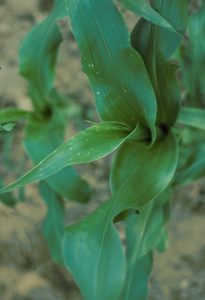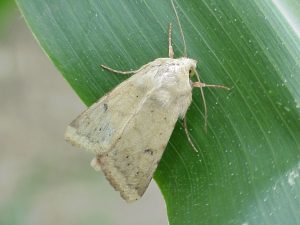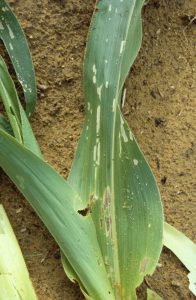Sweet Corn IPM Newsletter No. 3 – July 8, 2022
 Sweet Corn IPM Newsletter No. 3 – July 8, 2022
Sweet Corn IPM Newsletter No. 3 – July 8, 2022
CORN EARWORM ACTIVITY INCREASING
Early Silking Corn Requires Protection at Most Sites
Highmoor Farm Summer Tour and BBQ Dinner – Wednesday, July 27 from 1:30-7:30. Click here for more information.
SITUATION
Lots of early corn is starting to silk in southern Maine, while early-mid season corn is between pre-tassel and silking. Much of the state is now officially in a “moderate” drought, and some fields are showing symptoms of drought stress if they are not being irrigated, including stunting and rolled leaves. The result of drought stress on corn can be undersized ears and poor ear fill, so it is important to irrigate fields when and where possible. Early insect pressure continues to be significant this week, especially for fields in silk. All three of the major corn pests were found in our traps, with corn earworm populations increasing over the last week.

European corn borer: Larval feeding injury was over the 15% control threshold for pre-tassel corn at fields in Dayton this week, although feeding activity was observed in most fields. If more than five moths are caught during a week in silking corn, a spray is recommended. Early fields in Dayton were over the 5 moth threshold, but were either on a spray interval for corn earworm, or were not yet in silk, so no additional sprays were necessary.

Corn earworm: With many fields not yet in silk, it is important to remember that corn earworm is only a concern for fields with corn in the silk stage. A 6-day spray interval for fresh silking corn was recommended in Bowdoinham, New Gloucester, and one Wells site. A 5-day spray interval was recommended for Dayton, Lewiston and one Wells site.

Fall armyworm: Fall armyworm moths were caught at a few sites this week, but were only over the three-moth threshold for silking corn at one Dayton site, which was already under a spray interval for corn earworm. Larval feeding damage on leaves and tassels was seen for the first time this season at one site in Dayton, but was not yet over threshold.

Squash vine borer: Moths are now being caught in southern Maine, indicating that they are now laying eggs on squash and pumpkins. Squash vine borer moths are black and orange and resemble wasps. They lay their eggs at the base of squash plants. The larvae bore into the base of the plants, causing vines to wilt and collapse. Sprays are recommended when more than 5 moths are caught in a pheromone trap in a week, but if you are not using pheromone traps, initiate control when you begin to see the wasps, or borer damage on plants. Sites in Biddeford, Farmington and New Gloucester were all over the control threshold this week. See the New England Vegetable Management Guide for control options.
Highmoor Farm, the Maine Agriculture and Forest Experiment Station in Monmouth, Maine will hold a summer tour and BBQ dinner with an educational program on Wednesday, July 27, from 1:30 to 7:30 p.m. Click here for more information.
Sincerely,
David T. Handley
Vegetable and Small Fruit Specialist
Highmoor Farm UMaine Extension Diagnostic
P.O. Box 179 Research Lab, Pest Mgmt. Unit
52 U.S. Route 202 17 Godfrey Drive
Monmouth, ME 04259 Orono, ME 04473
207.933.2100 1.800.287.0279
Sweet Corn IPM Weekly Scouting Summary
| Location | CEW
Moths |
ECB
Moths |
FAW
Moths |
%Feeding
Damage |
Recommendations / Comments |
| Biddeford | 0 | 4 | 1 | 9% | No spray recommended |
| Bowdoinham | 3 | 4 | 0 | 7% | 6-day spray interval for silking corn |
| Cape Elizabeth | 1 | 1 | 0 | 4% | No spray recommended |
| Dayton I | 5 | 5 | 2 | 18% | 5-day spray interval for silking corn |
| Dayton II | 9 | 5 | 3 | 19% | 4-day spray interval for silking corn |
| Farmington | 0 | 1 | 0 | 8% | No spray recommended |
| Lewiston | 6 | 0 | 0 | 1% | 5-day spray interval for silking corn |
| Lewiston II | 4 | 6 | 0 | 4% | 5-day spray interval for silking corn |
| New Gloucester | 3 | 0 | 0 | 0% | 6-day spray interval for silking corn |
| Oxford | 0 | 0 | 0 | 0% | No spray recommended |
| Sabattus | 0 | 2 | 0 | 0% | No spray recommended |
| Wayne | 0 | 0 | 0 | 11% | No spray recommended |
| Wells I | 4 | 4 | 0 | 5% | 5-day spray interval for silking corn |
| Wells II | 2 | 0 | 2 | 3% | 6-day spray interval for silking corn |
CEW: Corn earworm (Only fresh silking corn should be sprayed for this insect.)
ECB: European corn borer
FAW: Fall armyworm
| European Corn Borer Thresholds
Whorl stage: 30% or more of plants scouted show injury. Pre-tassel-silk: 15% or more of plants scouted show injury. Silk: 5 or more moths caught in pheromone traps in one week. |
Corn Earworm Spray Thresholds for Pheromone Traps
| Moths caught per week | Moths caught per night | Spray interval |
| 0.0 to 1.4 | 0.0 to 0.2 | No spray |
| 1.5 to 3.5 | 0.3 to 0.5 | Spray every 6 days |
| 3.6 to 7.0 | 0.6 to 1.0 | Spray every 5 days |
| 7.1 to 91 | 1.1 to 13.0 | Spray every 4 days |
| More than 91 | More than 13 | Spray every 3 days |
Thresholds apply only to corn with exposed fresh silk. Lengthen spray intervals by
one day if maximum daily temperature is less than 80°F.
IPM Web Pages:
http://extension.umaine.edu/ipm/
http://www.pestwatch.psu.edu/sweet_corn.htm
https://ag.umass.edu/integrated-pest-management/
Where brand names or company names are used, it is for the reader’s information. No endorsement is implied nor is any discrimination intended against other products with similar ingredients. Always consult product labels for rates, application instructions and safety precautions. Users of these products assume all associated risks.
The University of Maine is an equal opportunity/affirmative action institution.
